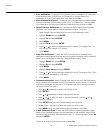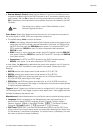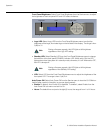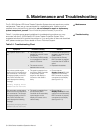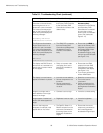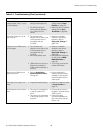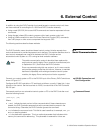
Maintenance and Troubleshooting
98 Q-1500d Series Installation/Operation Manual
PRE
L
IMINAR
Y
Neither the Secondary DHD
Controller nor the secondary
optical engine turns on or
responds to user commands.
The vacuum fluorescent dis-
play on the Primary DHD Con-
troller front panel displays the
following message:
Secondary DHD Error
Communication Failure
• The serial connection from
the Primary DHD Controller
to the Secondary DHD
Controller is incorrect or the
cable is faulty.
• Ensure that the RS-232 (To
Accessory Box)
connectors on the Primary
and Secondary DHD
Controllers are connected
to each other, using a
known-good, “null-modem”
(cross-over) cable (see
Figure 3-14).
The Brightness Acceleration
Engine does not turn on or
respond to user commands.
The vacuum fluorescent dis-
play on the Primary DHD Con-
troller front panel displays the
following message:
BAE Error
Communication Failure
• The HDMI CEC connection
from the Primary DHD
Controller to the Brightness
Acceleration Engine is
incorrect or the cable is
faulty.
• Ensure that the HDMI 1
input on the Primary DHD
Controller is connected to
the Primary HDMI output
on the Brightness
Acceleration Engine, using
a known-good HDMI cable
(see Figure 3-14).
The display and DHD Control-
ler both turn on, but there is no
picture and on-screen menus
do not appear.
• Faulty or incorrect video
connection from one or
both DHD Controllers to
the display.
• Ensure that the HDMI
outputs from both DHD
Controllers are properly
connected to the display
(see Figure 3-13).
• Try a known-good and/or
shorter HDMI cable.
The display is on and menus
appear, but there is no picture.
• Incorrect source selection.
• Source component is not
turned on.
• Source component is
connected incorrectly or
not at all.
• Select the correct source.
• Turn on the source
component.
• Check connections from
the source component to
the Brightness Acceleration
Engine.
Image is too bright and/or
lacks definition in the bright
areas of the image.
• Contrast is set too high. • Lower the contrast setting.
Image appears “washed out”
and/or dark areas appear too
bright.
• Brightness is set too high. • Lower the brightness
setting.
Colors in the image are
swapped; for example, reds
appear blue or vice versa.
• The Red/Pr, Green/Y or
Blue/Pb outputs from the
source are connected to
the wrong inputs on the
Brightness Acceleration
Engine.
• Ensure that the source
outputs are connected to
the correct Brightness
Acceleration Engine input.
Table 5-1. Troubleshooting Chart (continued)
Symptom Possible Cause(s) Solution



